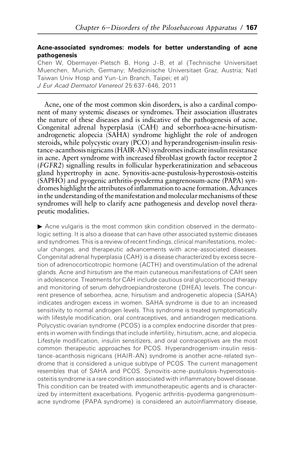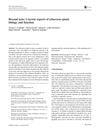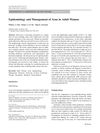Acne-Associated Syndromes: Models for Better Understanding of Acne Pathogenesis
January 2012
in “
Yearbook of Dermatology and Dermatologic Surgery
”
congenital adrenal hyperplasia seborrhoea-acne-hirsutism-androgenetic alopecia polycystic ovary syndrome hyperandrogenism-insulin resistance-acanthosis nigricans synovitis-acne-pustulosis-hyperostosis-osteitis pyogenic arthritis-pyoderma gangrenosum-acne Apert syndrome androgen steroids insulin resistance inflammation fibroblast growth factor receptor 2 oral glucocorticoids oral contraceptives antiandrogens immunotherapeutic agents dapsone frontal fibrosing alopecia hydroxychloroquine CAH SAHA syndrome PCOS HAIR-AN syndrome SAPHO syndrome PAPA syndrome FGFR2 glucocorticoids contraceptives immunotherapy FFA

TLDR Studying acne-related syndromes helps us understand acne causes and can lead to new treatments.
The document reviews acne-associated syndromes and their implications for understanding acne pathogenesis. It discusses how conditions like congenital adrenal hyperplasia (CAH), seborrhoea-acne-hirsutism-androgenetic alopecia (SAHA) syndrome, polycystic ovary syndrome (PCOS), hyperandrogenism-insulin resistance-acanthosis nigricans (HAIR-AN) syndrome, synovitis-acne-pustulosis-hyperostosis-osteitis (SAPHO) syndrome, pyogenic arthritis-pyoderma gangrenosum-acne (PAPA) syndrome, and Apert syndrome contribute to the understanding of acne. These syndromes highlight the roles of androgen steroids, insulin resistance, inflammation, and fibroblast growth factor receptor 2 (FGFR2) signaling in acne development. Treatments vary from oral glucocorticoids for CAH to lifestyle modifications, oral contraceptives, and antiandrogens for SAHA and PCOS. Immunotherapeutic agents are used for SAPHO syndrome, and dapsone for PAPA syndrome due to its antineutrophilic effects. The review suggests that further studies on these syndromes could lead to a better understanding of acne pathogenesis and the development of new treatments. Additionally, a clinical review of 36 patients with frontal fibrosing alopecia (FFA) found that hydroxychloroquine significantly reduced signs and symptoms of FFA at 6 and 12 months of treatment.




